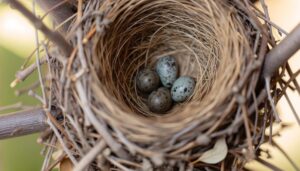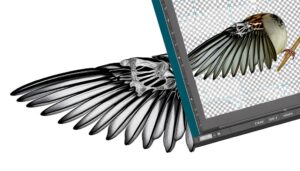Hatching a Sparrow Egg in 3 Steps
To hatch a sparrow egg, maintain a controlled environment using a reliable incubator. Guarantee a steady temperature of 37.5°C and humidity between 50-55%.
Equip the incubator with a calibrated thermometer and hygrometer. Place the egg pointed end down and rotate it at least three times daily to secure even development.
Monitor for hairline cracks and chirping sounds as indicators of imminent hatching. Consistent temperature regulation and humidity management are vital.
Use an egg candler to check internal development. These systematic steps provide a strong foundation for successful hatching.
Explore the detailed care essential for the chick post-hatching.
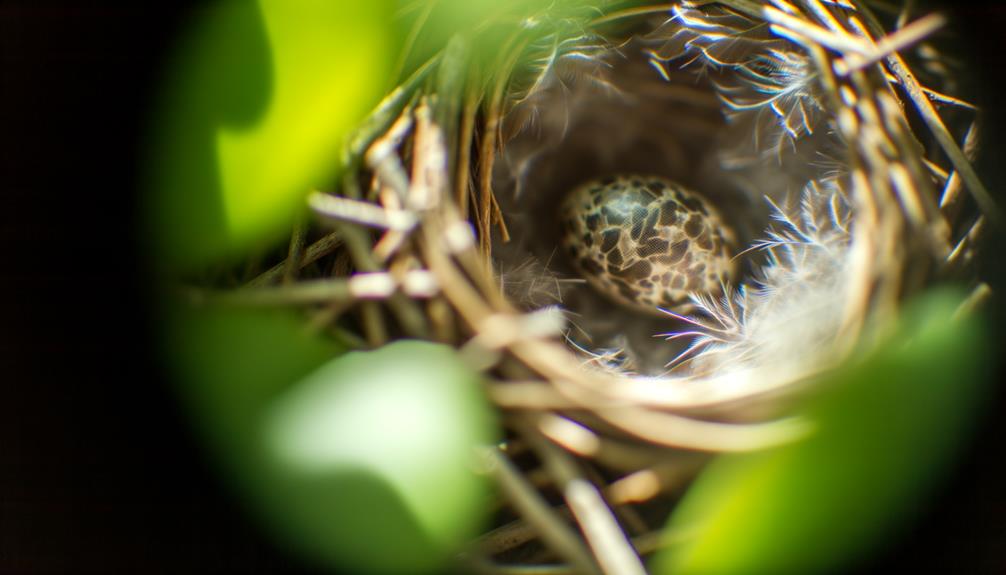
Key Takeaways
- Maintain the incubator temperature at 37.5°C and humidity at 50-55%.
- Place the sparrow egg pointed end down, ensuring they do not touch.
- Rotate the egg at least three times daily to ensure consistent development.
- Monitor for hairline cracks and internal movements using an egg candler.
- Listen for chirping sounds and knocking as signs of the chick's readiness to emerge.
Gathering Supplies
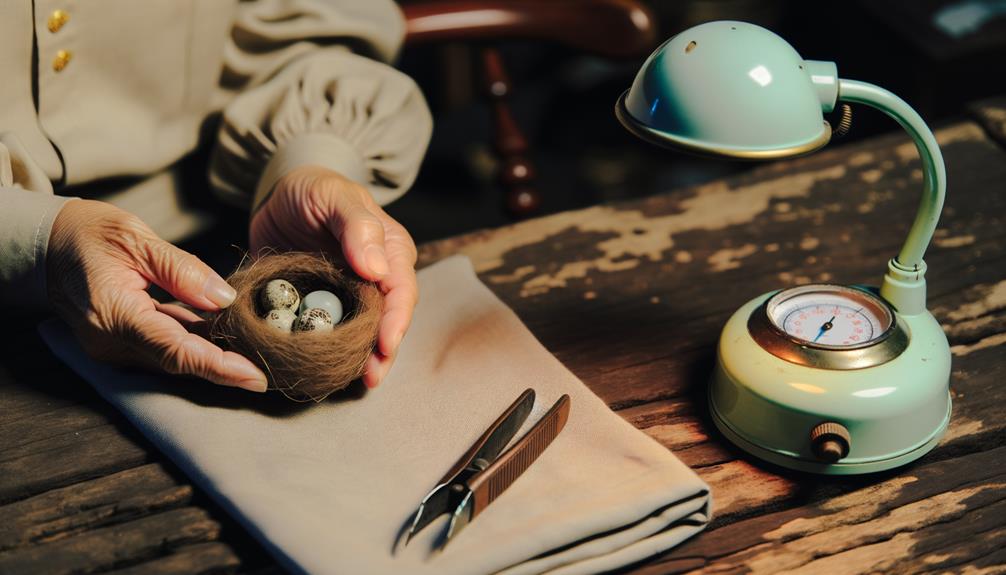
To successfully hatch a sparrow egg, it is crucial to gather the appropriate supplies. These include a dependable incubator, a calibrated thermometer, and a hygrometer to monitor humidity levels.
A high-quality incubator guarantees consistent temperature and humidity, both crucial for embryonic development. The thermometer must be accurate, with a precision of ±0.1°C, to maintain the ideal temperature range of 37.5°C.
The hygrometer should be digital for accurate readings, maintaining humidity between 40-50% during incubation and 60-70% during hatching. Additionally, consider acquiring an egg candler for periodic monitoring of embryo viability.
Each instrument must be correctly calibrated and tested before use to avoid fluctuations that could jeopardize the hatching process. These essential supplies are indispensable for successful sparrow egg incubation.
Setting Up the Incubator
Properly setting up the incubator involves ensuring precise temperature and humidity control to create an ideal environment for embryonic development. Begin by selecting an incubator capable of maintaining a stable temperature of 37.5°C (99.5°F).
Position the incubator in a location free from direct sunlight and drafts, which can cause fluctuations. Fill the water reservoir to maintain adequate humidity levels, typically between 50-55%. Install a digital thermometer and hygrometer for accurate readings.
Arrange the eggs in the incubator with the pointed end downward, ensuring they are not touching each other. Allow the incubator to run for several hours before introducing the eggs, ensuring all systems are functioning correctly.
Regular calibration and maintenance are essential for optimal performance.
Monitoring Temperature and Humidity
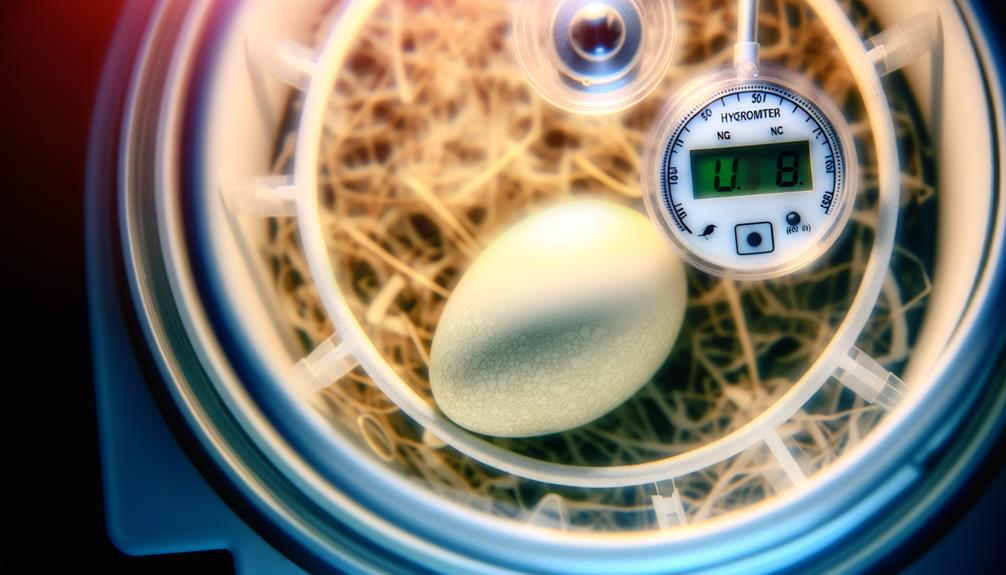
Maintaining ideal temperature and humidity within the incubator is essential for the successful development and hatching of sparrow eggs. The best temperature range is 37.5°C to 37.7°C, guaranteeing consistent thermal conditions. Deviations can result in embryonic deformities or mortality.
Humidity levels must be kept between 45% and 55% relative humidity (RH) during incubation, increasing to 65% to 70% RH during the final three days preceding hatching. Utilize a calibrated digital thermometer and hygrometer for precise monitoring. Regularly check and record the readings at 4-hour intervals to achieve the best conditions.
Implement water trays or sponges to adjust humidity levels. Any observed fluctuations should be promptly addressed by adjusting the incubator's settings to sustain the necessary environmental conditions.
Turning the Egg
Regularly turning the egg is crucial to prevent the embryo from adhering to the shell membrane and to promote even development. This process guarantees optimal growth conditions by enabling the distribution of nutrients and temperature within the egg.
To achieve this, manually rotate the egg at least three times daily, alternating its orientation while maintaining a consistent temperature and humidity environment.
- Joy of witnessing life: Each turn nurtures the delicate beginnings of a sparrow's life.
- Anticipation of success: Every rotation brings you one step closer to a successful hatch.
- Commitment to care: Your dedication is essential for the thriving of the developing embryo.
Incorporating these meticulous actions will greatly enhance the likelihood of a healthy hatchling.
Recognizing Hatching Signs

Recognizing hatching signs in sparrow eggs necessitates close observation of specific indicators. Initial signs include the formation of cracks on the eggshell surface, often accompanied by discernible chick movement within.
Additionally, auditory cues such as soft peeping sounds can signal imminent hatching, requiring precise monitoring for accurate detection.
Eggshell Cracks Formation
The initial signs of hatching in sparrow eggs are often indicated by the appearance of fine, hairline cracks on the eggshell. These cracks result from the chick's internal pipping and subsequent movements. These preliminary fractures are a critical indicator of the impending emergence of the chick and should be monitored meticulously. Employing a gentle and non-invasive observational approach is paramount to avoid disrupting the hatching process.
Observing the first signs of life after the long incubation period is an exciting moment. The delicate nature of the cracks symbolizes the fragile beginning of life. Each crack represents progress and the promise of a new sparrow entering the world.
Careful documentation of these initial cracks will facilitate a better understanding of the hatching timeline.
Chick Movement Inside
One of the earliest and most definitive signs of imminent hatching is the observable movement of the chick inside the egg, often referred to as internal pipping. This stage typically occurs between day 10 and 14 of incubation.
During internal pipping, the chick begins to rotate and shift within the egg, applying pressure to the inner membrane. Careful monitoring is essential; using a candling device, one can detect these subtle movements.
Observing increased activity indicates that the chick is repositioning to break through the air cell membrane. This movement is a precursor to external pipping, where the chick starts to crack the eggshell.
Recognizing these signs is essential for successful hatching, ensuring timely intervention if necessary.
Auditory Cues Detection
During the final stages of incubation, auditory cues such as faint chirping sounds and rhythmic knocking from within the egg can serve as vital indicators of the chick's progression towards hatching. These acoustic signals are essential markers that the embryo is evolving into the final phase of development. Careful observation and documentation of these sounds can provide invaluable insights into the chick's viability and readiness to emerge.
Subtle Chirping: Early vocalizations signify respiratory system activation.
Rhythmic Knocking: Indications of beak engagement with the eggshell.
Intermittent Silence: Periods of rest, important for energy conservation.
Monitoring these auditory cues systematically can enhance the likelihood of a successful hatch, enabling timely intervention if necessary.
Caring for the Chick
Upon successful hatching, the primary considerations for ensuring the chick's survival include precise feeding regimens and strict thermal regulation.
Best nutritional intake should be provided through a consistent schedule of appropriately formulated diets, rich in necessary proteins and fats.
Concurrently, maintaining an ambient temperature of approximately 35-37°C is essential to mimic the natural warmth provided by the parent sparrow.
Feeding the Chick
Observing proper nutrition for a newly hatched sparrow chick involves understanding its dietary needs and providing appropriate food sources that mimic what it would receive in the wild.
Initially, sparrow chicks require a diet high in protein to support rapid growth and development. A finely ground mixture of hard-boiled egg yolk and mealworms can replicate the insect-based diet provided by adult sparrows.
Feeding should occur every 20-30 minutes during daylight hours, using a small dropper or tweezers to deliver the food directly to the chick's beak.
Patience in frequent feedings
Precision in food preparation
Commitment to the chick's survival
Observing these methods guarantees the chick receives the necessary nutrients for healthy growth, fostering a strong foundation for its eventual independence.
Maintaining Warmth
Maintaining ideal warmth for a newly hatched sparrow chick is crucial to ensuring its survival and proper development. The best temperature range for a hatchling is between 35°C to 37°C. Utilizing an incubator or a brooder with precise temperature control is recommended. Continuous monitoring with a reliable thermometer is essential.
The chick's environment should also have a humidity level of approximately 50-60% to prevent dehydration. Regularly check for signs of hypothermia, such as lethargy or lack of vocalization, and hyperthermia, indicated by panting or spreading wings. Adjust the heat source accordingly to maintain stability.
Insulate the chick's habitat with soft, non-abrasive materials to retain warmth while ensuring adequate ventilation to prevent overheating.
Conclusion
To sum up, successful hatching of a sparrow egg demands meticulous attention to detail, akin to orchestrating a delicate symphony of life.
By methodically gathering supplies, precisely setting up the incubator, rigorously monitoring temperature and humidity, diligently turning the egg, and astutely recognizing hatching signs, one can witness the emergence of a fragile chick, a proof to the wonders of avian reproduction.
This process exemplifies the intricate balance of environmental control and biological understanding required in aviculture.

